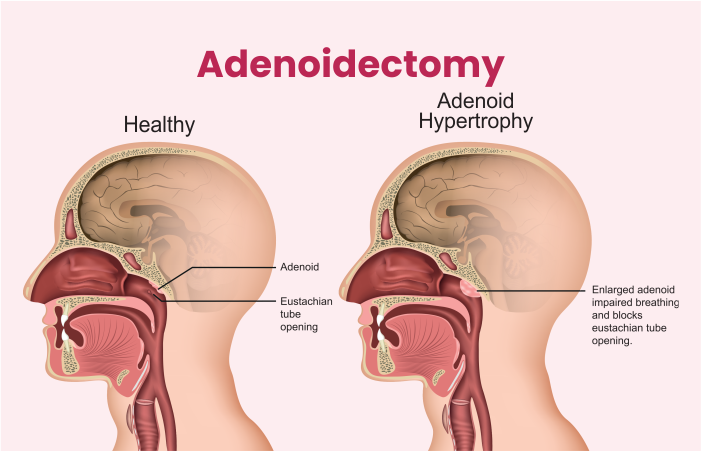Adenoidectomy Surgery in Hyderabad

Adenoidectomy Surgery
Adenoidectomy surgery is a medical procedure performed to remove the adenoids, which are small glands located at the back of the nasal cavity. This article provides comprehensive information about adenoidectomy surgery, including its purpose, preparation guidelines, details about the procedure itself, and the potential consequences of delaying the surgery. Additionally, it highlights the availability of adenoidectomy surgery hospitals in Hyderabad, the cost of the surgery in the region, and the importance of choosing the best hospital for adenoidectomy.

Why is Adenoidectomy Surgery Performed?
Adenoidectomy surgery is performed for various reasons:
- Chronic infections: When the adenoids become repeatedly infected, causing symptoms such as persistent sore throat, difficulty breathing, and ear infections, removal may be necessary.
- Enlarged adenoids: Enlarged adenoids can lead to nasal congestion, obstructed breathing, snoring, and sleep disturbances, affecting overall quality of life.
- Eustachian tube dysfunction: Enlarged adenoids can impact the function of the Eustachian tubes, leading to ear infections and hearing problems.
- Recurrent sinusitis: Adenoids that contribute to recurrent sinus infections may necessitate their removal.
How to Prepare for Adenoidectomy Surgery:
Preparing for adenoidectomy surgery involves the following steps:
- Consultation: Schedule a consultation with an ENT specialist or otolaryngologist at an adenoidectomy surgery hospital in Hyderabad.
- Medical evaluation: The specialist will conduct a physical examination, review the medical history, and may order diagnostic tests, such as X-rays or throat cultures, to assess the condition of the adenoids.
- Preoperative instructions: Follow the surgeon’s instructions regarding fasting, medication use, and any necessary lifestyle modifications leading up to the surgery.
- Anesthesia options: Discuss the anesthesia options with the surgeon to determine the most suitable choice for the procedure.
More About Adenoidectomy Surgery:
Adenoidectomy surgery is typically performed under general anesthesia. The surgeon uses specialized instruments to remove the adenoids through the mouth, without the need for external incisions. The procedure is relatively quick, and most patients can return home on the same day. Post-surgery, some discomfort, mild bleeding, and a sore throat are common, but they subside with time. Follow the surgeon’s instructions regarding pain management, diet, and activity restrictions during the recovery time.
Consequences of Delaying Adenoidectomy Surgery:
Delaying adenoidectomy surgery can have various consequences:
- Recurrent infections: Enlarged or infected adenoids can lead to persistent infections, resulting in frequent throat infections, sinusitis, and ear infections.
- Impaired breathing and sleep disturbances: Enlarged adenoids can obstruct nasal passages, leading to breathing difficulties, snoring, and disrupted sleep patterns.
- Speech and language development issues: Prolonged adenoid-related breathing difficulties can affect speech development in young children.
- Persistent ear problems: Delaying surgery can contribute to ongoing ear infections, fluid buildup in the middle ear, and potential hearing loss.
- Long-term complications: If left untreated, chronic adenoid-related issues can lead to complications such as chronic sinusitis, middle ear problems, and reduced immunity.
Frequently Asked Questions (FAQs)
The adenoids are lymphoid tissues located at the back of the nasal passage, near the opening of the Eustachian tubes. Adenoidectomy surgery is performed to remove the adenoids when they become enlarged or infected. Common reasons for this surgery include persistent or recurrent infections, chronic nasal congestion, obstructed breathing, sleep apnea, or recurring ear infections.
Adenoidectomy surgery is typically performed under general anaesthesia. The surgeon accesses the adenoids through the mouth without making any external incisions. The adenoids are carefully removed using specialised instruments. The surgery is relatively quick, typically lasting around 30 minutes or less. Following the procedure, the individual is monitored in the recovery area before being discharged.
The recovery process after adenoidectomy surgery is usually straightforward. Sore throat, mild pain, and a low-grade fever may be experienced for a few days following the surgery. Over-the-counter pain relievers, throat lozenges, and plenty of rest can help alleviate discomfort. It is important to follow postoperative instructions provided by the surgeon, including dietary recommendations and activity restrictions, to ensure proper healing.
Adenoidectomy surgery is generally safe, but like any surgical procedure, it carries some risks and potential complications. These may include bleeding, infection, breathing difficulties, voice changes, nasal regurgitation, or recurrence of adenoid tissue. It is important to discuss these risks with your surgeon before the surgery and to seek immediate medical attention if any unusual symptoms or complications occur.
The benefits of adenoidectomy surgery are usually noticeable within a few weeks after the procedure. Breathing may become easier, nasal congestion may improve, and symptoms such as snoring or sleep apnea may be alleviated. However, it is important to note that individual results may vary. It is recommended to follow up with the surgeon to monitor progress and address any concerns or persistent symptoms.









